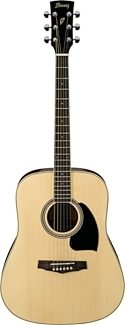
Ibanez PF15WC Dreadnought Acoustic Guitar (with Case)
An incredible value, the PF15WC dreadnought from Ibanez is packed with crisp, focused tone, thanks to its spruce top and maghogany back and sides.
Overall User Ratings (based on 1 ratings)
Submitted September 14, 2014 by Richard M in Fort Mohave, AZ
"Where do I start?"
Verified Customer
zZounds has verified that this reviewer made a purchase from us.
To start off, before anyone gets their feelings hurt, I am an Ibanez guitar lover, and have over 20 of them.
As delivered from Zzounds, the guitar was a complete disaster.
The best part of what was delivered, was the guitar case which is a semi-hard case consisting of nylon fabric cover (like a gig bag) with molded and covered, hard foam interior sections.
The fret job is the worst I have ever seen on a new guitar; the frets are clipped, with no dress at all.
After tuning the guitar and taking that first strum, I wanted to throw up, as it sounded like a badly made shoebox guitar.
Next, I went through the frets, which were pitted, and discovered that two of them were loose and high which caused the high e and B to go dead from the seventh to ninth frets.
Because I have over 120 guitars in my collection, I have to work on a lot of my own guitars, and posses the tools and ability to do most work including fret, bridge, neck replacement, Etc. Etc., pressing the two frets down and redressing them is no big deal, other than time. I have found the best way to check for high frets (not seated properly) is to use a short metal rod, 1/2" to 3/4" Dia., and about 3" long. You want the rod to sit on 3 to 4 frets at a time. By holding down the rod hard on the frets, and then pressing on one side and another (rocking), and moving it from fret set to fret set, you will be able to discern a slight rocking when a fret is high.
So, bad frets found, pressed (and glued, as they would not stop going dead) and dressed back into place. Fret edges block filed at the proper angle, filed, sanded, and crowned.
Oh, by the way, the fret radius is 9.5 inches.
When removing the strings, the nut popped off, and one of the bridge pins broke off, so replaced all the pins, and put a little white glue on the nut and cleaned up the grooves, as they were full of plastic filings from machining.
Replaced the 11-52 strings with new Martin 11-52's, and will probably try a set
Of 12's down the road.
Tightened the tuning pegs down, as they were flopping around, and treated the fretboard.
The guitar sounds OK now, but the frets edges will need more work (normal), as I continue to play the guitar.
I must admit, that I bought two guitars the same week, and the other was a flawless Epiphone EJ-200CE with NO PROBLEMS!
Up front, this did spoil me a bit.
To get this guitar right, you would have dumped $200.00-$400.00 at your local guitar shop for a $165.00 guitar.
Methinks this makes no sense.......................
Musical Background:
Professional drummer. Hobby guitar, bass, Keyboards
Musical Style:
Rock, Blues, Jazz
1 of 1 people (100%) people found this review helpful. Did you?
Thanks for your opinion!
Please wait.